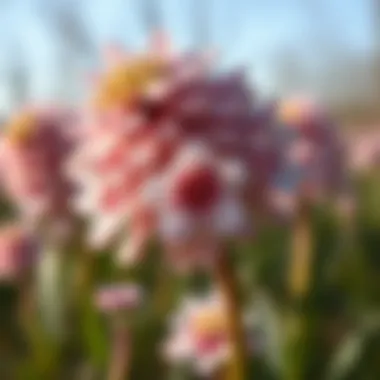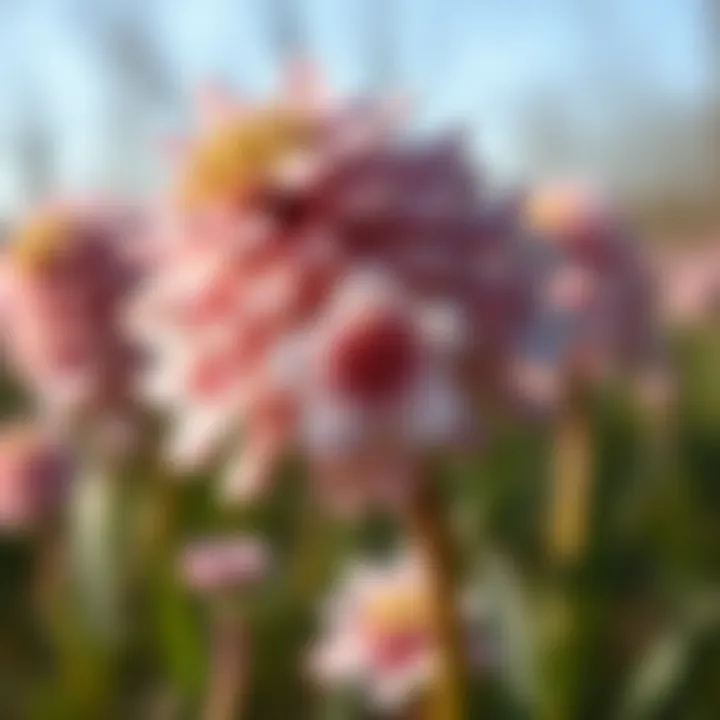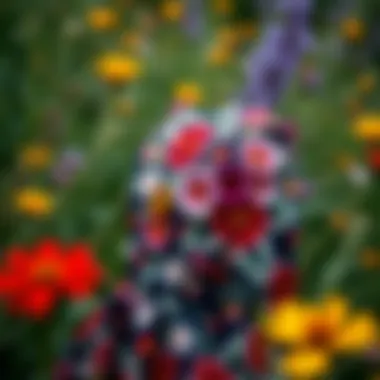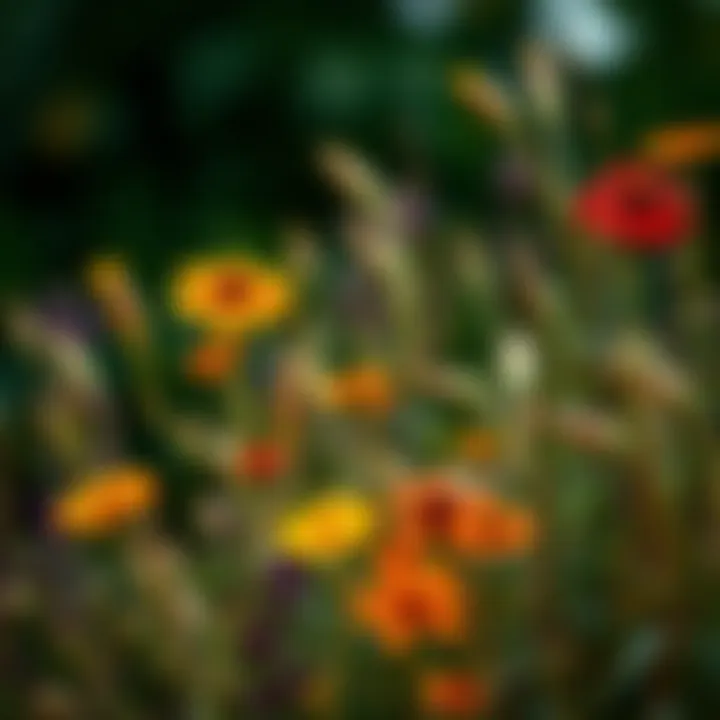Discovering Wildflower Patterns in Fashion and Design


Intro
Wildflowers have long played an enchanting role in our ecosystems, appearing with a vibrancy that both delights the eye and supports a healthy environment. These modest beauties don’t just paint the fields with color; they also act as critical players in the ecological ballet of pollination and habitat support. Now, they are stepping out from their natural surrounds and into the spotlight of the fashion and design world, captivating designers and consumers alike.
The concept of a wildflower canvas isn’t simply about aesthetics—though their visual appeal is certainly captivating. It encapsulates a deeper connection between humans and nature, exploring how these floral patterns can translate into the cutting-edge creations seen on runways today. In this discourse, we will examine the intricate relationship wildflowers have with both ecology and artistry, diving into their emergence as a significant trend in the domains of fashion and design. Understanding how these patterns enrich our wardrobe and inspire creativity helps fashion enthusiasts, retailers, and designers thrive in this vibrant intersection of nature and artistry.
Let’s embark on this exploratory journey, tracing the roots of wildflower motifs in modern fashion while detailing how to style and maintain garments adorned with these enchanting designs.
Preface to Wildflower Canvases
Wildflower canvases present a unique intersection of nature’s splendor and human creativity. These vibrant displays serve not only as a visual feast but also reflect the deep-rooted relationship between ecological systems and artistic expression. As we dive deeper into the world of wildflower patterns, it’s essential to understand their multidimensional significance, especially in today’s fast-paced design landscape.
Definition and Concept
At its core, a wildflower canvas represents more than just a gathering of florals; it encompasses the myriad forms and colors that bloom across natural landscapes. Wildflower canvases can be seen as living art that thrives in fields, meadows, and along roadsides. They’re composed of diverse species, each contributing a specific hue or shape to the overall tableau.
When we think of wildflower canvases, we are often drawn to their chaotic yet harmonious nature, a reflection of biodiversity itself. This concept embodies how these patterns serve as blueprints for inspiration in various design fields, ensuring that the beauty of nature can be woven seamlessly into the fabric of human artistry. Wildflowers thus transcend mere botanical categories, merging artistry with ecological identity, offering designers a wellspring of creativity from the earth itself. Understanding this foundation is crucial as it opens pathways to appreciating their applications in fashion, art, and beyond.
Historical Context
The significance of wildflower patterns is not a recent phenomenon. Historical texts, dating back centuries, reflect early human fascination with nature’s designs. From the intricate tapestries of ancient civilizations to the floral motifs in Renaissance paintings, wildflowers often adorned spaces where people interacted with nature's beauty. Cultures around the world have revered flowers—not only for their aesthetic appeal but for their symbolism as well. For instance, in various indigenous communities, certain wildflowers signify renewal and resilience, directly linking them to cultural narratives and practices.
With the rise of the Arts and Crafts movement in the late 19th century, there was a tangible shift towards embracing natural forms in artistic expressions. Influential figures like William Morris drew inspiration from the countryside, creating wallpaper and textile designs that celebrated wildflower aesthetics. This trend marked a reclaiming of nature as a primary source of inspiration in art and design, emphasizing ecological harmony and sustainability long before these concepts gained traction in modern discourse.
As the industrial revolution ushered in mass production and urbanization, the appreciation for wildflower designs became a subtle counterpoint to the artificial. Many artists began to rethink the role of nature within design, ultimately embedding themes of wildflowers into various modalities of art. This enduring legacy continues to shape contemporary approaches to fashion and design, bridging the past and the present with a commitment to appreciating the intricate palette of colors and patterns that nature provides.
"Wildflowers are not just plants; they are reflections of history, artistry, and the very essence of biodiversity."
In the following sections, we will explore the ecological importance of wildflower patterns, their aesthetic appeal, and their growing influence in modern fashion, understanding how they interconnect with each facet of human life and creativity.
Ecological Importance
Understanding the ecological importance of wildflowers provides a crucial backdrop to their aesthetic and cultural roles. The vibrant hues and intricate designs of wildflower patterns are visually captivating, but their benefits to the ecosystem are what make them truly invaluable. Wildflowers serve as a lifeline not just for wildlife but also for the delicate balance of natural systems around us.
These plants are often the unsung heroes in maintaining biodiversity, supporting various ecosystems by providing habitats and food sources for numerous species. Their existence is a fundamental aspect of sustainable practices, allowing ecosystems to flourish and evolve.
Biodiversity and Ecosystems
Wildflowers act as focal points around which biodiversity blooms. They are among the first plants to rise in spring, often preceding the leaves on trees. This timing is no accident; it allows them to take advantage of sunlight, while also providing food for pollinators and other wildlife when resources are scarce. By drawing in a variety of pollinators such as bees, butterflies, and birds, these plants facilitate necessary pollination processes, which in turn help to maintain genetic diversity among plant species.
When assessing the relationship between wildflowers and biodiversity, consider the following:
- Nutrient Cycling: Wildflowers contribute to soil health by supporting a diverse array of microorganisms, which break down organic matter and recycle nutrients back into the soil.
- Pest Control: Wildflowers can attract beneficial insects that prey on pests, thereby reducing the need for chemical pesticides in agricultural settings.
- Habitat Formation: The dense growth of wildflowers can create microhabitats that protect vulnerable species and promote a rich tapestry of life.
By completing this virtuous cycle of support, wildflowers help to create resilient ecosystems capable of withstanding environmental changes.
Role in Pollination
The role of wildflowers in the pollination process extends beyond mere aesthetics; it plays a vital role in food production and environmental balance. Pollinators are instrumental in fertilizing flowers by transferring pollen from one bloom to another, enabling plants to produce seeds and fruit. Without these wildflower champions, much of the food we depend on cannot be produced.
To further illustrate this significance, consider the variety of plants that rely on pollinators:
- Fruits and Vegetables: Many crops, including apples, strawberries, and almonds, depend on bees and other pollinators which are drawn to the flowering plants.
- Wildlife Food Sources: Numerous animals depend on the seeds and fruits from wildflowers as a primary food source.
- Ecosystem Resilience: Pollinators contribute to the stability of ecosystems by enhancing the reproductive success of wildflowers, which helps ensure a consistently healthy environment.
"Pollinators are a critical link in the chain of life, yet are often overlooked in conversations about conservation."
Aesthetic Appeal of Wildflower Patterns
The beauty of wildflower patterns transcends mere visuals; they evoke emotions, reminisce of sun-dappled meadows, and reflect nature’s unrefined artistry. These patterns play a significant role in the world of fashion and design, bridging our connection to nature with the aesthetics of clothing and art. The intricate dance of colors, shapes, and textures found in wildflowers can profoundly influence the stylistic choices made by designers and stylists alike.
Color Schemes and Compositions


Wildflower patterns offer an impressive range of color schemes that draw the eye and can alter the mood of a piece. From vibrant yellows and reds to subtle purples and whites, these hues can be combined in ways that either complement or contrast with one another, providing versatility in design.
Consider the palette of a simple daisy against a rich backdrop of green foliage: it’s a striking example of how a few well-placed colors can elevate a garment’s appeal. Designers who harness these natural compositions can create pieces that celebrate the vibrancy of life.
- Nature's Palette: Nature offers an array of colors that designers can use, ranging from vivid florals to gentle pastels. This diverse spectrum allows clothes to stand out or blend in as needed, catering to individual tastes and seasonality.
- Emotional Impact: Colors can elicit feelings. A shirt adorned with bright wildflower patterns may evoke joy and warmth, while darker hues might conjure introspection and elegance.
Ultimately, the aesthetic input of wildflowers is not just limited to their radiant colors – the very arrangement or composition of these designs can create movement or harmony within a garment, attracting attention in all the right ways.
Artistic Interpretations
Wildflowers are not only visual elements but also sources of inspiration across various art forms. From painting to photography, each medium captures the essence and complexity of these natural wonders, adding another layer to their aesthetic appeal.
Painting
When it comes to painting, wildflowers serve as subjects steeped in both tradition and innovation. Artists utilize these flowers to encapsulate the eternal beauty of nature while also expressing personal perspectives.
- Key Characteristic: The fluidity of paint allows for texture and depth, effectively mimicking the delicate nature of wildflowers. Using oils or watercolors, artists can create pieces that either stay true to life or delve into abstraction, reflecting their inner interpretations.
- Advantages: The unique feature of painting wildflowers lies in the artist's ability to layer colors, giving a sense of movement and vibrancy. One major advantage is how artists can play with light and shadow; this not only enhances the visual appeal but also adds emotional depth.
But, the challenge remains – how to balance realism with imagination while depicting flowers that exist in a spontaneous, organic form.
Photography
In the realm of photography, the wildflower’s fleeting beauty is captured in intimate detail. Photographers seek out moments where light hits petals just right, creating images that can mesmerize and inspire.
- Key Characteristic: The power of photography lies in its immediacy. It captures a moment in time, allowing the viewer to appreciate the flowers in their most vibrant state.
- Advantages: A significant advantage of this medium is accessibility. With advancements in technology, even amateur photographers can freeze a wildflower moment, thus showcasing its beauty to a broader audience. However, the challenge lies in creating images that stand out in a world saturated with visuals.
Sculpture
Sculpture provides a tactile approach to wildflowers, turning ephemeral blooms into lasting forms. Artists mould materials like stone or clay into intricate representations of flowers, allowing for three-dimensional exploration of these designs.
- Key Characteristic: The permanence of sculpture contrasts the temporality of flowers, creating a dialogue about nature's fleeting existence. Sculptors often focus on form and structure, emphasizing the delicate yet strong qualities of wildflowers.
- Advantages: The unique advantage here is the embodiment of flowers in a tangible form. This allows for a deeper connection with the viewer, inviting them to navigate around the piece and experience it from various angles. But, the challenge lies in capturing the essence of such delicate elements in a robust medium.
In essence, each artistic expression involving wildflowers contributes to the broader narrative of how beauty is perceived and interpreted. The intricate details, varying styles, and innovative approaches render these practices as essential facets of the aesthetic appeal that wildflower patterns present.
Wildflowers in Fashion
The allure of wildflowers extends beyond the natural landscape; they have become a significant source of inspiration in the world of fashion. Designers often look to these delicate blooms not just for their visual appeal but also for the emotional connections they evoke. Wildflower patterns bring a breath of fresh air into collections, adding a touch of whimsy and spontaneity that resonates with consumers seeking beauty and authenticity in their clothing choices.
Inspiration for Designers
Wildflowers are a muse with an ever-changing palette. Designers are drawn to their shapes, colors, and organic growth, which can translate into stunning fabric designs. A striking feature of wildflowers is their variability; no two blooms are the same, and this variability allows for creativity without boundaries. Motifs inspired by wildflowers can be playful and vibrant or subtle and elegant, catering to diverse fashion sensibilities.
Many designers incorporate these patterns into their collections, seeing wildflowers as a bridge between art and nature. It’s not unusual to find wildflower designs breaking traditional norms, combining contrasting elements such as bright colors with soft, flowing fabrics. This infusion of nature into contemporary fashion captivates the imagination and speaks to the desire for a more grounded, eco-conscious approach in style.
Seasonal Trends
Wildflower designs are notably influenced by the changing seasons, with particular trends emerging in both spring and summer collections. Understanding these seasonal implications helps to shape an effective fashion narrative, appealing to consumers at just the right time.
Spring Collections
Spring collections bloom with anticipation, mirroring the vibrant awakening of nature. The key characteristic of spring wildflower patterns is their light, airy colors that signify renewal and growth. Light pastels and bright hues dominate this season, which convey youthful exuberance and optimism. Designers emphasize floral prints, often using techniques that replicate the random beauty of nature.
The unique feature of spring collections is their capacity to blend together traditional floral designs with modern silhouettes. This mix has advantages such as appealing to both a conservative and contemporary audience. However, one disadvantage may be the potential over-saturation of floral patterns, making it crucial to innovate in design and application.
Summer Patterns
When summer rolls around, wildflower patterns shift to bolder, more dynamic presentations. The key characteristic of summer patterns leans towards vivid colors that reflect the life force of the season, capturing the heat and vibrancy of the outdoors. Bright yellows, deep blues, and rich reds feature prominently, evoking a sense of joy and freedom.
For summer, designers often explore larger prints and more abstract interpretations of wildflower themes. These designs tend to resonate well in casual clothing and resort wear, providing a relaxed vibe essential for leisurely summer days. A unique advantage of summer patterns is their adaptability across various fabric types, from breathable cotton to luxurious silk, ensuring options for versatile styling. That said, one must be cautious of the styles becoming too overwhelming if not balanced with simpler pieces.
In summary, wildflower patterns present a lively fusion of art, nature, and fashion, providing endless inspiration for designers. Their influence on seasonal trends expands the horizons of creativity and sustainability, urging the fashion world to remain connected with its roots in nature. The dance between natural beauty and textile design might well be the new frontier in eco-conscious fashion.


Sustainable Practices and Wildflower Designs
In an era where the environment is becoming an increasingly paramount concern, the relationship between sustainable practices and wildflower designs deserves a closer look. This connection is not merely a trend; it is a vital consideration that shapes the future of fashion and design. As society moves towards more ethical consumption, understanding sustainable practices becomes crucial for stylists, fashion designers, and retailers alike.
The beauty of wildflower designs often resembles nature's untamed artistry and can inspire various creative processes. However, integrating sustainability into these designs is essential for maintaining ecological balance. The benefits of adopting these practices range from reducing waste to supporting local ecosystems, providing an avenue for the fashion industry to align itself with the ethos of care for our planet.
Ethical Sourcing of Materials
Ethical sourcing underpins sustainable wildflower designs, serving as the cornerstone for many successful fashion brands today. It involves acquiring materials in a way that is both respectful of labor rights and the environment. For example, using organic cotton or bamboo fabric, which utilizes fewer chemicals compared to conventional methods, aligns with this principle.
When designers opt for ethically sourced materials, they also contribute to biodiversity. Choosing materials from wildflower-rich areas helps maintain these ecosystems. Moreover, sourcing from local growers reduces the carbon footprint associated with transportation while supporting community economies.
Consider these aspects when implementing ethical sourcing:
- Identify Sustainable Suppliers: Research and collaborate with suppliers committed to environmental stewardship.
- Support Fair Trade: Partner with brands that ensure fair wages and safe working conditions for workers.
- Local Sourcing: Look for locally available materials to minimize environmental impact.
"Sustainability isn't just about how a product is made; it's about the entire chain from seed to final product."
Eco-Friendly Production Techniques
Once materials have been ethically sourced, the next step is utilizing eco-friendly production techniques. Traditional manufacturing often exacerbates environmental problems, such as excessive water use and chemical runoff. By adopting greener methods, the fashion industry can mitigate some of these adverse effects.
One innovative approach is the use of digital printing technology, which consumes less water and energy than conventional printing methods. This technique allows for vibrant wildflower patterns without the need for harsh chemicals. Another method gaining traction is the use of natural dyes derived from plants and flowers. Not only does this align with the wildflower theme, but it also maintains the integrity of the natural environment.
Some eco-friendly techniques to consider include:
- Zero-Waste Pattern Cutting: Designing patterns that minimize fabric waste.
- Waterless Dyeing: Exploring advancements in dyeing technology that eliminate water usage altogether.
- Biodegradable Fabrics: Investing in materials that break down naturally at the end of their lifecycle.
By embracing these sustainable practices, designers not only create beautiful pieces but also contribute to a healthier planet. As the awareness of sustainable fashion continues to grow, incorporating wildflower designs in a mindful manner can set the stage for innovation in both aesthetics and ethics.
Cultural Significance
Understanding the cultural significance of wildflowers provides an added layer of appreciation for their presence in our lives. Wildflowers are not merely a feast for the eyes; they serve as cultural symbols woven through the tapestry of human experience. From ancient rituals to contemporary art, these delicate blossoms deeply influence various realms of society.
Historically, wildflowers have held meanings that resonate across different cultures and time periods. They often symbolize different sentiments, such as love, hope, and remembrance. For example, deep red poppies are frequently associated with sacrifice and are a powerful emblem in memorials for veterans. This emotive connection between flowers and human experiences shapes how individuals and communities articulate their identity and values.
Cultural narratives surrounding wildflowers extend beyond mere symbolism. They find representation in folklore, stories, and even religious traditions. For example, in some Native American cultures, the sunflower signifies warmth and adoration, while the bluebell can denote humility. The manner in which various communities celebrate or cultivate these flowers speaks volumes about their intrinsic place in societal customs.
Symbolism of Wildflowers
Wildflowers are imbued with profound symbolism, often reflecting the values, beliefs, and emotional landscapes of the cultures that embrace them. Different wildflower types can symbolize vastly different ideas, sometimes even opposing concepts.
- Daisies represent innocence and purity; they are often associated with new beginnings and childhood.
- Lilies might denote a pure heart and renewal, making them prominent in both weddings and funerals.
- Chrysanthemums, particularly in Asia, symbolize longevity and happiness, adding a layer of joy to celebrations.
Such associations are not just random; they resonate deeply within the lifeblood of cultures, often surfacing during significant life events. Flowers, in this way, become a language in themselves, allowing individuals to express feelings or sentiments that may otherwise be difficult to articulate. Various cultures have adopted specific flowers for their celebrations, infusing gatherings with deeper meanings through their floral choices. For instance, in Japan, cherry blossoms embody the beauty and transience of life, celebrated during the Hanami festival.
Cultural Representations in Art and Fashion
The influence of wildflowers extends prominently into the realms of art and fashion. From Impressionist painters who delicately captured wildflowers in their landscapes to modern designers inspired by floral motifs, these blooms have abundant presence across creative expressions. Artists have long found inspiration in the vibrant forms and colors of wildflowers. Monet’s series of water lilies is an iconic example, where flowers transform into the very essence of emotional expression in art. Such representations explore the delicate interplay between nature and human emotion, illustrating how wildflowers serve as a muse in the creative process.
In fashion, the infusion of wildflower patterns into clothing designs showcases their broader cultural significance. Floral prints are not merely decorative; they narrate stories of femininity, renewal, and earthiness. Influential fashion designers such as Erdem and Isabel Marant employ these motifs to evoke a sense of nostalgia and connect consumers to nature, subtly conveying a message about care and sustainability.
Moreover, the resurgence of eco-conscious fashion incorporates wildflower patterns, blending aesthetics with ethical practices. By choosing natural dyes derived from wildflowers or emphasizing floral designs in seasonal collections, designers challenge consumers to reflect on their connections with nature and the broader implications of their fashion choices.
Thus, the representation of wildflowers in art and fashion is an ongoing dialogue, a complex exchange that enriches the cultural fabric while fostering a renewed appreciation for the natural world.
Mixing and Matching with Wildflower Patterns
Mixing and matching wildflower patterns in fashion is not merely an exercise in aesthetics; it’s a bold declaration of a style that breathes life into clothing. This approach encourages an integration of colors and textures that evoke the vibrant, chaotic beauty of nature. For designers and stylists, understanding how to effectively blend wildflower motifs can open up a world of creativity, offering unique combinations that captivate and inspire. The core of this practice lies in appreciating how different patterns can complement each other, producing an ensemble that feels both fresh and coherent.
Combining Textures and Colors


When it comes to wildflower designs, textures play an indispensable role in the final appearance of garments. Visualizing a dress adorned with delicate daisies against a backdrop of soft linen creates an organic appeal, prompting a connection to nature. The importance of color scheme cannot be overstated; hues inspired by wildflower petals—rich purples, sunny yellows, and deep blues—can enhance the wearability of patterns. For instance, pairing a soft floral blouse with a rugged denim jacket can create a delightful contrast, marrying femininity with a touch of edginess.
Some considerations when combining textures and colors include:
- Contrast vs. Coordination: Sometimes, opposites attract; other times, color harmony is key. Aim for designs where the colors either clash in a chic way or blend seamlessly to maintain visual interest.
- Saturation Levels: Consider the depth of your colors. A light, pastel wildflower design on a cotton fabric might require grounding with deeper shades represented in accessories or other layers.
- Print Scale: Don’t forget that wildflower motifs can vary in scale. A large print can shine when counterbalanced by a smaller, subtler pattern elsewhere in the outfit.
- Textile Weight: A lighter fabric in a floral print can work harmoniously with heavier textiles, as this interplay often adds depth to a look.
In practical terms, stylists might find that adopting a mantra of "start where the flowers bloom" can serve them well. This means picking a floral piece as the centerpiece and building around it, resulting in looks that bloom wonderfully.
Layering Techniques
Layering is both an art and a science in the realm of fashion, particularly when working with wildflower designs. The strategic use of layers not only provides versatility but enhances the visual complexity of an outfit. A well-layered ensemble can tell a story—a visual journey through different styles and eras. Just as wildflowers grow in layers in nature, so too can our outfits reflect this structure.
Consider the following strategies when layering wildflower patterns:
- Base Layer: Start with a foundational piece that is simple and understated, allowing the wildflower patterns to take center stage. For example, a solid color tank can form the base for an intricate wildflower jacket.
- Transitional Pieces: These are quite valuable. A lightweight scarf with a wildflower print can be effectively used for a pop of color or pattern, making it easy to switch up the look throughout the day.
- Outer Layers: Don’t shy away from bold choices. A structured coat adorned with wildflowers can transform a basic outfit into a statement look. Ensure the outer layer complements the underneath pieces, as conflicting motifs can become visually overwhelming.
- Accessorizing: Accessories are key players in any layered look. A wide-brimmed hat or patterned shoes can resonate with the wildflower theme without overpowering it. Choose items that reinforce the overall design narrative without detracting from the central motifs.
"The wilderness holds the tightest of secrets, a whisper of aesthetic guidance to those who dare to listen."
For more information on wildflower patterns and their applications in design, visit Britannica.
Discover more about sustainable fashion practices at Wikipedia.
Engage in discussions about layering techniques on platforms like Reddit to gain insights from fellow fashion enthusiasts.
Future of Wildflower Designs in Clothing
As we navigate through an age where sustainability and creativity converge, the future of wildflower designs in clothing holds significant importance. Wildflowers, with their spirited colors and varied shapes, offer not just artistic inspiration but also a way to champion ecological mindfulness in fashion. The intricate patterns inspired by nature resonate well with the growing consumer base that seeks to marry style with responsibility. By incorporating wildflower motifs, designers can evoke a sense of natural beauty while promoting awareness about biodiversity.
Incorporating wildflower designs into clothing serves various beneficial roles. Firstly, it caters to a demographic that values authenticity and sustainability. As more individuals lean towards eco-friendly choices, brands that embrace natural inspirations can establish stronger connections with their customers. Moreover, wildflower designs celebrate the beauty of imperfection, breaking away from rigid, standardized patterns often found in mass production.
Emerging Trends
The landscape of fashion is witnessing a vibrant transformation, driven by evolving consumer preferences and environmental concerns. Among the leading trends is the shift towards seasonal adaptability in wildflower patterns. This means that designs are not constrained to spring or summer; instead, the color palettes are being adapted across seasons.
- Muted Earth Tones: Designers are leaning towards softer pastels or earthy hues during fall and winter, bringing a sense of warmth to garments that traditionally might adopt more somber colors.
- Layering Wildflower Patterns: The trend of layering different floral patterns has gained traction. It's becoming more common to see wildflower motifs paired with stripes or polka dots, creating a striking visual juxtaposition.
- Sustainable Dyeing Techniques: As technology advances, natural dyeing techniques using plant-based materials are making a comeback, aligning with the wildflower theme and enhancing sustainability. Designers like Eileen Fisher are already paving the way in this realm.
Innovations in Fabric and Print Technology
The marriage of technology and nature brings exciting changes to wildflower designs in clothing. Advances in fabric and print technology are rendering it easier for designers to experiment with designs while retaining eco-friendliness. One groundbreaking innovation is digital printing, which allows for intricate, multi-colored patterns that are hard to achieve through traditional means.
Another significant development is in the realm of biodegradable fabrics. These materials not only minimize environmental impact but also often lend themselves well to displaying nature-themed designs like wildflowers. The use of fibers derived from recycled plastics or organic cotton further reinforces the link between fashion and ecological responsibility.
"Fashion is not just about clothes; it's a canvas for a story that intertwines artistry with nature. As we embrace wildflower designs, we tell the world that beauty can exist without harming our environment."
The integration of wildflower designs, fueled by innovative techniques, presents exciting opportunities for the fashion industry. From trendy, sustainable collections to avant-garde pieces that challenge conventional norms, the dynamic world of wildflower fashion sits at the intersection of art and ecological stewardship. This not only reflects the current zeitgeist but sets a precedent for future trends in style—where nature is celebrated and embodied through clothing.
Concluding Thoughts
As we round off our exploration into the vibrant world of wildflower canvases, it becomes evident how intertwined the realms of nature and design truly are. Wildflowers are not just a playful burst of color in the environment; they encapsulate a broader narrative about biodiversity, sustainability, and artistic expression. For stylists and fashion designers who seek to infuse their creations with the essence of the natural world, understanding these flowers and their patterns is not merely beneficial but essential.
Reflections on Nature and Design
The relationship between nature and design goes beyond aesthetics. One could say that nature offers a treasure chest of inspiration, where every petal whispers secrets of beauty and diversity. Designers, whether conscious of it or not, often draw from this wealth. The intricate details of a wildflower—its unique shapes, vivid colors, and seasonal adaptations—translate into endless possibilities for clothing patterns and textile designs.
Moreover, as environmental consciousness rises among consumers, awareness about the textiles we choose and their ecological footprints becomes increasingly important. For instance, adopting wildflower patterns can serve as a statement, a reflection of one’s values, and a commitment to sustainable fashion practices. Designers are encouraged to look at local ecosystems for inspiration, promoting the idea of think globally, act locally. Understanding the local flora not only enhances the design process but also bridges the gap between art and natural conservation.
The Ongoing Relationship between Art and Environment
Art and environment have always danced a delicate tango. As art evolves, so too must our approach to sourcing materials and designing our creations. The incorporation of wildflower motifs into fashion is not just a trend; it's a dialogue with the environment. Through art, we can communicate our values and concerns regarding ecological issues, advocating for biodiversity and sustainable practices.
Often, one might hear that art imitates life, but it’s crucial to consider that life, particularly the environment, equally influences art. As trends shift towards organic fabrics and natural colors, the lessons learned from the study of wildflowers become indispensable. It's about finding harmony between innovation in textile technology and the preservation of natural beauty. Creatives are encouraged to weave these narratives into their work, ensuring that our artistic expressions do not come at the cost of our planet.
"Nature always wears the colors of the spirit." - Ralph Waldo Emerson
For further reading on the intersection of art, environment, and sustainable fashion practices, check resources at Britannica, Wikipedia, and forums like Reddit.
By embracing the wildflower, both in spirit and in our material choices, we embark on a journey that celebrates creativity, diversity, and environmental stewardship.







